Pisa class armoured cruisers (1907)
 Italy – Regia Marina Pisa, Amalfi
Italy – Regia Marina Pisa, Amalfi
Based on the Regina Elena Battleships
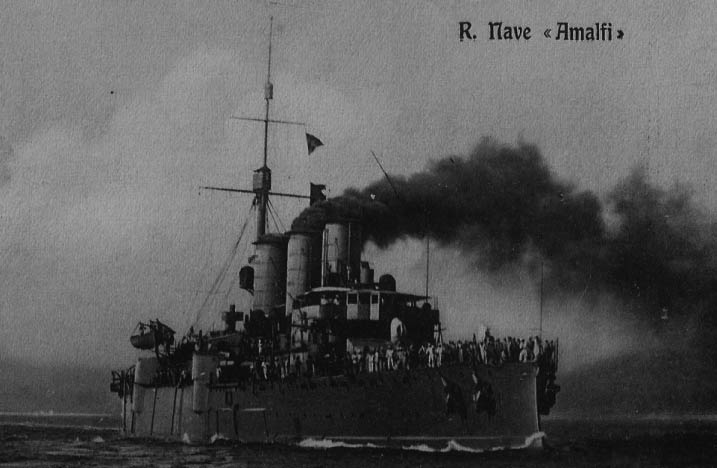
These two ships were designed in August 1904 by engineer Giuseppe Orlando on the model of the Regina Elena, but in reduced version.
They were started at Orlando, Leghorn, and Odero at Sestri Ponente in February and July 1905, launched in September 1907 and May 1908 and commissioned in September 1909, six years after their conception.
They remained inferior to the battlecruisers that appeared at the same time. Actually, a third of the class was built, for the Greek Navy, the Giorgios Averoff, launched in March 1910 and completed in 16 May 1911. She took a major part in the Greek-Turkish war and remained in service during WW2, being only deactivated as a museum ship in 1984. She is the only remaining cruiser of this class to be visited today.
Design of the Pisa class
Armament
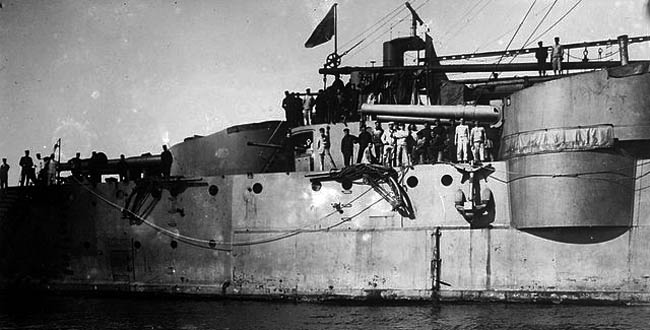
Close view on Pisa’s turrets
Unlike the Rgina Elena class battleships supposed to be based on, the two Pisa had four Cannone da 254/45 V Modello 1906 in twin mounts for and aft. They were hydraulically powered and the 254 mm (10.0 in) guns fired 217–224-kilogram (478–494 lb) armor-piercing (AP) projectiles at about 869 mps (2,850 ft/s). The third ship, Averoff, was fitted instead with smaller 234 mm (9.2 in) British Vickers guns (more on the Averoff to come).
Secondary armament comprised mounted eight Cannone da 190/45 V Modello 1906 in twin mounts, also hydraulically powered. They were placed on each side amidships and fired 91-kilogram (201 lb) AP shells at 850–870 mps (2,789–2,853 ft/s). But the Averof, once again, was armed with Vickers 190 mm (7.5 in) guns and these Elswick artillery piece were Pattern ‘B’ 7.5-inch furing similar 90.7-kilogram (200 lb) AP shells, a bit slower at 844 m/s (2,770 ft/s).
Tertiary armament comprised a solid defence against torpedo boats comprising the same 16 Vickers quick-firing (QF) Cannone da 76/50 V Modello 1908 artillery pieces, firing a 6.5-kilogram (14 lb) projectile at 930 mps (3,100 ft/s), plus eight on the Pisa and Amalfi and four on the Georgios Averof QF Cannone da 47/40 V Modello 1908 guns. As usual for close quarter, three submerged 450 mm (17.7 in) torpedo tubes were installed. However Georgios Averof had 457 mm (18.0 in) tubes instead (standard Britsih TT caliber).
Wartime modifications concerned the suviving Pisa only, which had its entire tertiary armament replaced by twenty modern dual purpose or AA 76/40 guns (six AA guns). Georgios Averof was also modernized but received just one additional 76 mm AA gun, changed after her 1925 refit to six 76 mm (4 low-angle, 2 AA guns) plus nine 47 mm (4 low-angle, 5 AA) 40 mm AA guns.
Protection
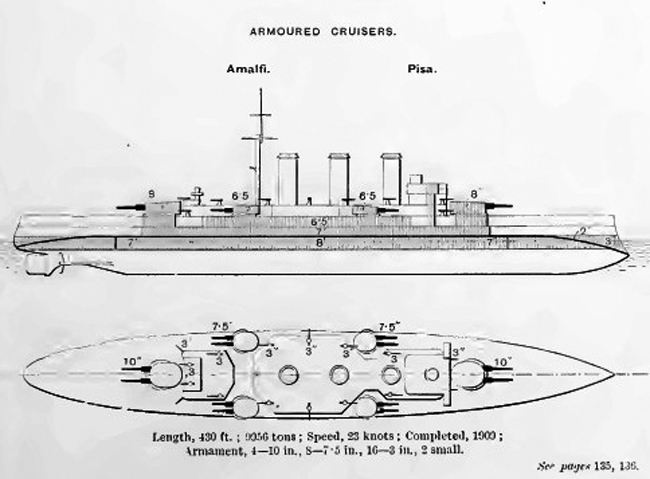
Protection was similar in all three ships: They had an armored belt 200 mm (7.9 in) in nessthick amidships, down to 90 mm (3.5 in) bow and stern. The armored deck was 51 mm (2.0 in) in thickness and the conning tower 180 mm (7.1 in). The main gun turrets were had 160 mm (6.3 in) armour on the frontal arc and side, and the 190 mm turrets 140 mm (5.5 in). By comparison the contemporary Minotaur class, which succeeded to the British Duke of Edinburgh and Warrior classes were even faster at 23 knots, had four smaller 234 mm guns but ten 190 mm secondary guns (two more) to compensate, and 254 mm on their conning tower and blockhaus but a lighter 152 mm belt, 203 mm on the turrets and only 20 mm on the decks.
Propulsion
All three ships were powered by two vertical triple-expansion steam engines (VTE), connected to two shaft, while steam came from 22 Belleville boilers. The whole maximum output was as designed, 20,000 horsepower (15,000 kW) and designed speed of 22.5 knots (41.7 km/h; 25.9 mph). On trials both the Amalfi and Pisa reached 23.47–23.6 knots (43.47–43.71 km/h; 27.01–27.16 mph) obtained from a forced heated machinery at 20,260–20,808 ihp (15,108–15,517 kW). Cruising range at 12 knots was about 2,500 nautical miles (4,600 km; 2,900 mi), reduced to 1,400 nautical miles (2,600 km; 1,600 mi) if the ships reached 21 knots (39 km/h; 24 mph).
Career of the Pisa and Amalfi
The career of the Amalfi was shortened during the conflict since she was sunk by the UB14 (U26 under Austro-Hungarian flag), on July 7, 1915 in the north of the Adriatic. A German submarine operating under the Austrian flag sank her. Indeed officially the Kaiser was not yet at war against Italy.
Pisa for her part received a foremast, her tertiary artillery was modified with the addition of fourteen 76 mm guns and six 76 mm AA. In 1921 she was relegated to coastal defense, then became a training ship. A Macchi M7 reconnaissance aircraft was carried in 1925, and she later served as a cadets training ship and for naval lieutenants. She was retired from service in April 1937.
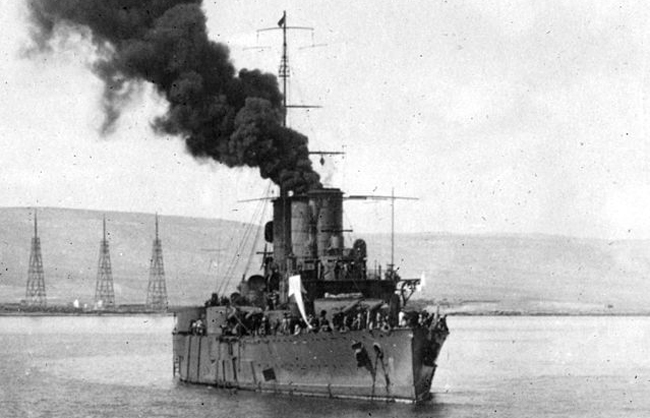
Pisa off Derna in 1912
Pisa
Pisa was the flagship of Rear-Admiral Ernesto Presbitero, commander of the 2nd Division of the 1st Squadron of the Mediterranean Fleet when the Italo-Turkish war broke out. She started the initial blockade of Tripoli with her sister-ship, searched for the Ottoman navy, and landed troops for the occupation of Tobrouk. She escorted along with Marco Polo and destroyers a convoy bound to Derna and shelled the port when negotiations broke down. The town was razed and taken on October 18 after several days of siege and constant bombardment. She also escorted troops from sicily and attempted to seize the port of Zuara before Christmas 1911.
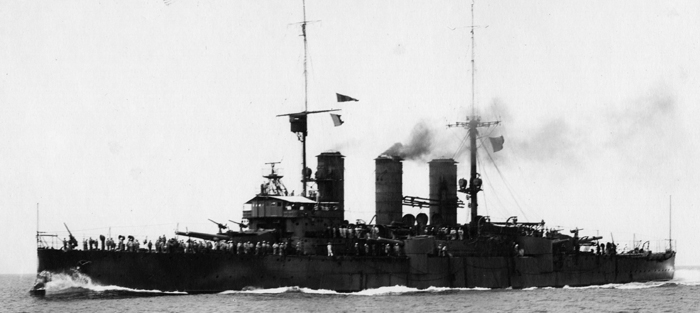
Early in 1912, the cruiser was in operations in the eastern Aegean Sea to try to lure out the Ottoman fleet, and shelled the Dardanelles forts while other ships systematically destroyed telegraph and radio stations, plus cutting underwater cables. With her sister ship she landed her armed crews to take the island of Astropalia on 28 April and convert it as a supply base, while she later covered the landings and occupation of Rhodes on 4 May. She spent some time after peace was signed, anchored at Constantinople and roaming the Aegean sea, showing the flag.
She later operated at Taranto, and Brindisi when the war broke out for Italy in 1915. During the war, she was redeployed at Venice by Admiral Paolo Thaon di Revel in order to prevent other sorties by the Austro-Hungarian fleet, bound on shelling coastal cities. After the loss of Amalfi she was transferred to Vlore, Albania in April 1916. She took part in the shelling of Durazzo on 2 October 1918. On 1 July 1921, Pisa was already considered a second-class battleship, and became coastal battleship doubling as training ship. In 1925 she was modified to operate a Macchi M.7 flying boat and until 1930, trained naval cadets and lieutenants.
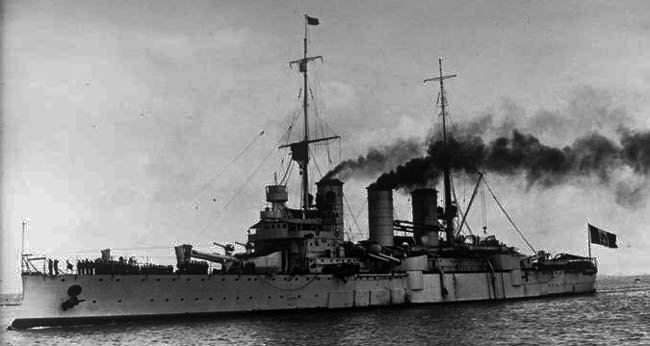
Pisa in 1932, bound to China.
Amalfi
There is little information in sources on Amalfi until the 1911 Italo-Turkish War (as for Pisa), however at the start of the war in 1911 she departed Syracuse for Tripoli with the bulk of the Regia Marina, comprising the battleships Roma and Napoli, armored cruisers Pisa, Giuseppe Garibaldi, Varese, and Francesco Ferruccio escorted by two flotillas of destroyers. She blockaded Tripoli after coaling at Malta, and on 15 October, was shelling Derna. In April 1912 she was in the Aegean Sea to bombard the Turkish coast and Dardanelles. Two squadrons had joined force from Tobrouk and Augusta and met at Stampalia on 17 April for the latter operations.
Amalfi and Pisa took over the dangerous task of entering deep the Dardanelles in order to draw out the Ottoman fleet. Meanwhile, they duelled for two hours with four Turkish batteries armed with 200 to 230 mm guns while the Italians fired at a range of 8,000 metres (8,700 yd). On 28 April she also landed a party of 250 men to fight off the Turkish garrison on the island of Astropalia and take the Island.
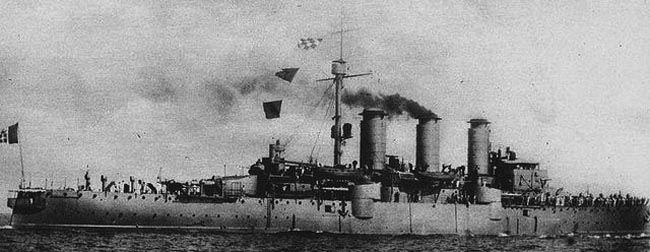
During the interwar (1912 and 1915) Amalfi escorted King Victor Emmanuel III on the royal yacht Trinacria to the regatta at Kiel in Germany. Then on Trinacria and Stockholm. She later greeted USN Admiral Charles J. Badger at Naples on USS Wyoming. When the war broke out for Italy, and later in May 1915 she was part of th squadron anchored at Brindisi, comprising six pre-dreadnought battleships, those of the Regina Elena class and Ammiraglio di Saint Bon plus the cruisers San Marco, San Giorgio and her sister-ship.
Under orders from Admiral Anton Haus, the Austro-Hungarian Navy raided Italian coast on the night of 23/24 May 1915 to disrupt the Italian mobilization, striking Ancona hard. The fleet safely made home, showing some form of impunity, while the Italian fleet was just too far away to do anything. Pressure from Rome to act translated send the fleet to Venice to supplement the local fleet, and it acted as planned as a deterrent against further raids, while this made a tempting prize for the Austrian U-boats roaming in the sector.
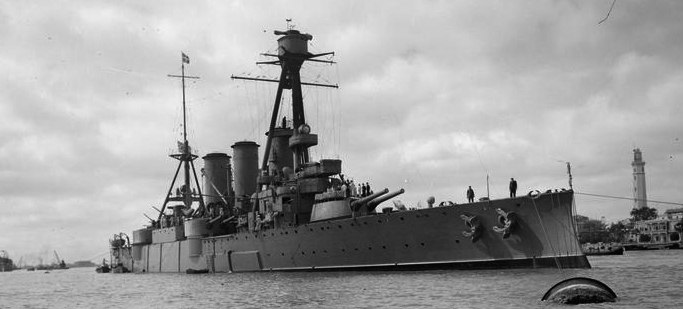
Indeed, the consequence was dire for Amalfi and her light underwater protection. Shortly after her arrival at Venice, she made reconnaissance mission near the Austro-Hungarian port of Pula during the night of 6/7 July 1915. Making it back to Venice she was only 20 nautical miles (37 km; 23 mi) when she was torpedoed by the Austrian submarine U-26 at dawn. The latter was the rebranded UB-14, flying the Austrian flag, under command of Oberleutnant zur See Heino von Heimburg. He was just making his first patrol and was awarded at his return.
The unfortunate cruiser sank relatively slowly (30 minutes), listing to port and gradually evacuated. Distress calls to the division also made many ships arrive to save the crew. However losses were about 200, down to 67 fatalities in an official report. Pisa and the other armored cruisers at Venice stayled mostly inactive in harbor due to the result of this action before being ordered to Valona in April 1916.
Illustration of the Pisa in 1914
Pisa-class specifications |
|
| Dimensions | 140.5 x 21 x 7.1 m () |
| Displacement | 9832t, 10 600tonnes FL |
| Crew | 687 |
| Propulsion | 2 shafts VTE, 22 Belleville boilers, 20,000 hp. |
| Speed | 23 knots (31 km/h; 20 mph) |
| Range | 5,800 nmi (10,700 km; 6,700 mi) at 10 knots (19 km/h; 12 mph) |
| Armament | 4 x 254 (2×2), 8 x 190 (4×2), 16 x 76, 8 x 47, 4 MGs, 3 TT 450 mm sub. |
| Armor | Belt 200, Decks 51, CT 180, turrets 160-130 mm |
Sources/Read more
https://en.wikipedia.org/wiki/Pisa-class_cruiser
http://www.navypedia.org/ships/italy/it_cr_pisa.htm
Campbell, John (1985). Naval Weapons of World War II. Annapolis, Maryland: Naval Institute Press.
Fraccaroli, Aldo (1970). Italian Warships of World War I.
Carr, John C. (2014). R.N.H.S. Averof: Thunder in the Aegean.
Friedman, Norman (2011). Naval Weapons of World War One.
Gardiner, Robert & Gray, Randal, eds. (1984). Conway’s All the World’s Fighting Ships: 1906–1921 and Conway’s all the world fighting ships 1860-1905.


 Latest Facebook Entry -
Latest Facebook Entry -  X(Tweeter) Naval Encyclopedia's deck archive
X(Tweeter) Naval Encyclopedia's deck archive Instagram (@navalencyc)
Instagram (@navalencyc)





 French Navy
French Navy Royal Navy
Royal Navy Russian Navy
Russian Navy Armada Espanola
Armada Espanola Austrian Navy
Austrian Navy K.u.K. Kriegsmarine
K.u.K. Kriegsmarine Dansk Marine
Dansk Marine Nautiko Hellenon
Nautiko Hellenon Koninklije Marine 1870
Koninklije Marine 1870 Marinha do Brasil
Marinha do Brasil Osmanlı Donanması
Osmanlı Donanması Marina Do Peru
Marina Do Peru Marinha do Portugal
Marinha do Portugal Regia Marina 1870
Regia Marina 1870 Nihhon Kaigun 1870
Nihhon Kaigun 1870 Preußische Marine 1870
Preußische Marine 1870 Russkiy Flot 1870
Russkiy Flot 1870 Svenska marinen
Svenska marinen Søværnet
Søværnet Union Navy
Union Navy Confederate Navy
Confederate Navy Armada de Argentina
Armada de Argentina Imperial Chinese Navy
Imperial Chinese Navy Marinha do Portugal
Marinha do Portugal Mexico
Mexico Kaiserliche Marine
Kaiserliche Marine 1898 US Navy
1898 US Navy Sovietskiy Flot
Sovietskiy Flot Royal Canadian Navy
Royal Canadian Navy Royal Australian Navy
Royal Australian Navy RNZN Fleet
RNZN Fleet Chinese Navy 1937
Chinese Navy 1937 Kriegsmarine
Kriegsmarine Chilean Navy
Chilean Navy Danish Navy
Danish Navy Finnish Navy
Finnish Navy Hellenic Navy
Hellenic Navy Polish Navy
Polish Navy Romanian Navy
Romanian Navy Turkish Navy
Turkish Navy Royal Yugoslav Navy
Royal Yugoslav Navy Royal Thai Navy
Royal Thai Navy Minor Navies
Minor Navies Albania
Albania Austria
Austria Belgium
Belgium Columbia
Columbia Costa Rica
Costa Rica Cuba
Cuba Czechoslovakia
Czechoslovakia Dominican Republic
Dominican Republic Haiti
Haiti Hungary
Hungary Honduras
Honduras Estonia
Estonia Iceland
Iceland Eire
Eire Equador
Equador Iran
Iran Iraq
Iraq Latvia
Latvia Liberia
Liberia Lithuania
Lithuania Mandchukuo
Mandchukuo Morocco
Morocco Nicaragua
Nicaragua Persia
Persia San Salvador
San Salvador Sarawak
Sarawak Uruguay
Uruguay Venezuela
Venezuela Zanzibar
Zanzibar Warsaw Pact Navies
Warsaw Pact Navies Bulgaria
Bulgaria Hungary
Hungary

 Bundesmarine
Bundesmarine Dutch Navy
Dutch Navy Hellenic Navy
Hellenic Navy Marina Militare
Marina Militare Yugoslav Navy
Yugoslav Navy Chinese Navy
Chinese Navy Indian Navy
Indian Navy Indonesian Navy
Indonesian Navy JMSDF
JMSDF North Korean Navy
North Korean Navy Pakistani Navy
Pakistani Navy Philippines Navy
Philippines Navy ROKN
ROKN Rep. of Singapore Navy
Rep. of Singapore Navy Taiwanese Navy
Taiwanese Navy IDF Navy
IDF Navy Saudi Navy
Saudi Navy Royal New Zealand Navy
Royal New Zealand Navy Egyptian Navy
Egyptian Navy South African Navy
South African Navy






























 Ukrainian Navy
Ukrainian Navy dbodesign
dbodesign
Looking for a crew roster of Amoured Cruiser Almafi